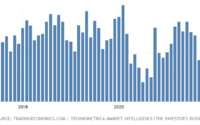“Does It Even Matter If The Fed Hikes 50 Or 75bps? It Won’t Prevent The Multiple Trainwrecks Coming Our Way”
By Elwin de Groot and Bas van Geffen, Macro Strategists at Rabobank
When reading the financial press these days, one could be forgiven for getting the impression that right now it’s “all about the Fed’s next move and what Powell is going to say on Friday”. Our colleague Philip Marey gave his views in yesterday’s Global Daily and with his key message basically being that it is time now that market participants are to be told ‘the truth’. And the truth, unfortunately, is not a happy message: inflation is already so much entrenched now that the Fed cannot afford to take its foot off the brakes, no matter what the economy or the labor market do in the foreseeable future.
Yet in the grander scheme of things, one could also ask: does it even matter whether the Fed adds another 75bp or 50bp? It would neither speed up nor prevent the multiple trainwrecks that seem to be coming our way. Although Joseph Stiglitz, in an interview in Germany, argued that too forceful rate hikes could even exacerbate inflation if higher interest rates slow down the necessary investments to alleviate supply shortages. Is he now in the Erdogan camp? But it is difficult to argue against his observation that rate hikes don’t solve energy and food shortages; a point we have been making from the start of this crisis.
So the awful truth is that it’s real and potentially (very) bad, not matter how you twist or turn things. The current scorching European summer is likely to end up in the history books as one of the driest in centuries. Those who have visited the south of Europe in recent months can probably attest: extremely dry fields, trees shedding their leaves, the closure of nuclear plants due to lack of cooling water, and water-saving measures all around. The impact on harvests could be significant and the impact on electricity prices is already a fact. The French 1m forward baseload power contract briefly hit EUR 700/MWh on Monday, where some EUR 50/MWh was the norm in the five years up to 2021 (an average household in France uses about 5.5MWh per year).
But now China has also joined the Drought Club or, rather, the country is dealing with both drought and floods. Heavy rainfalls in the north of the country have triggered severe flash foods, whereas high temperatures have caused significant water shortages in the south. The latter is not only affecting hydropower output in the region (18% of its energy production in 2020), forcing greater use of coal, but also puts food production at risk. Particularly along the Yangtze River and the Sichuan basin, where around half of the nation’s rice is produced, the situation is said to be perilous. Xinhua news reported that, “as of Monday, drought has affected 3.4 million people and 48.48 million mu [3.23 million hectares] of farmland in 10 provincial-level regions in the Yangtze River basin, including Chongqing, Sichuan and Hubei.”. China’s Cabinet said it will set aside CNY 10bn to support rice production.
However, should the droughts force China to increase food imports, this could put further pressure on global food commodity prices. The sharp decline in the FAOs food price index in July –albeit after even sharper gains since January– was met with some relief last month. But this index has probably risen again in August, underscoring that the risk of global food shortages has not receded. Far from that, actually. And the recent rise in natural gas prices is only aggravating the longer-term risks. Yesterday, CF Industries Holdings Inc., a major fertilizer producer, said that its UK unit intends to temporarily halt ammonia production as it’s “uneconomical” at current gas and carbon prices. This obviously spells more trouble ahead. According to the UN’s FAO nearly 30% of the global population was experiencing modest to severe food insecurity (up from 25% in 2015) and it’s hard to believe that this trend has reversed in the past two years.
As we have noted before, the squeeze on households’ incomes is real. And Western governments are looking at ways to soften the blow. Yesterday, US President Biden has announced plans to forgive up to $10,000 in student loans, which are a burden for many Americans. The amount of federal student debt outstanding amounts to $1.6 trillion, and then there are the loans that were issued by private parties. About one in five Americans has a student loan, although the amounts will be relatively small for most of them (less than $20,000). That said, these borrowers often find it hardest to repay their debt – simply because these smaller amounts are held by former students that moved on to lower paying jobs. So Biden’s policy will certainly help many US households. The Biden administration boasted that 90% will go to those earning under $75,000 per year. Technically, that may be true. However, it will mostly go towards the middle class, while the lowest income quintile benefits much less – simply because this group is less likely to have attended tertiary education.
Meanwhile, there are concerns that this waiver could further boost inflation. After all, it gives these households a little more disposable income. And that burden would also partly fall on the shoulders of lower income households, many of which are already struggling to cope with higher prices, e.g. for electricity. Although the increase in US energy bills pales in comparison to the price hikes faced by Europeans, there are now 20 million households in arrears on their utility bills, which could see the power being shut off (temporarily) for many Americans. Yet, the US government does not seem to be in a hurry to offer any assistance on that front – unlike the quick measures that are taken as soon as prices at the gas station rise significantly.
[ad_2]
Source link


